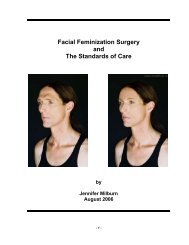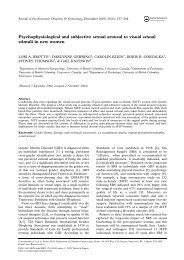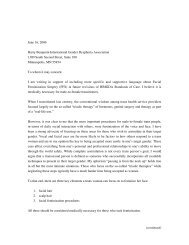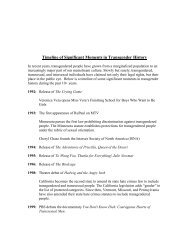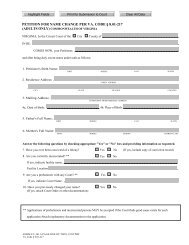A defining moment in our history - Transsexual Road Map
A defining moment in our history - Transsexual Road Map
A defining moment in our history - Transsexual Road Map
You also want an ePaper? Increase the reach of your titles
YUMPU automatically turns print PDFs into web optimized ePapers that Google loves.
Andrea JamesA <strong>def<strong>in</strong><strong>in</strong>g</strong> <strong>moment</strong> <strong>in</strong> <strong>our</strong> <strong>history</strong>this to <strong>in</strong>dulge an autoerotic <strong>in</strong>terest? Should <strong>in</strong>surance companies give outhigh heels as “palliative treatment” for shoe fetishists?As Lawrence notes, “There are many human behaviors that look like thesame th<strong>in</strong>g, but really aren't.” 37 Previous medical attempts to cataloguebehavior like Lawrence’s were not only pathologiz<strong>in</strong>g, but <strong>in</strong>sult<strong>in</strong>g: Peoplelike Lawrence were “transvestitic applicants for sex reassignment” 38 whoare “ag<strong>in</strong>g” 39 and “distressed,” 40 suffer<strong>in</strong>g from “pseudotranssexualism” 41a “non-transsexual” variant of “gender identity disorder” (GIDAANT), 42and “iatrogenic artifact.” 43 Many notable “borderl<strong>in</strong>e” cases are doctors:Renee Richards, Anne Lawrence, Gregory/Gloria Hem<strong>in</strong>gway. They mayepitomize these published observations. They all self-treated, vacillated, and“detransitioned” to vary<strong>in</strong>g degrees, and all three challenge exist<strong>in</strong>gdiagnostic categories. 44 If <strong>in</strong>terest <strong>in</strong> fem<strong>in</strong>ization is an iatrogenic artifact (adisease made up by doctors), wouldn’t doctors be the best evidence of that?Further, why would Dr. Marci Bowers transition without <strong>in</strong>cident <strong>in</strong> thesame hospital group that forced Anne Lawrence to resign? Do they reallyhave the same “disease”? I have never heard Dr. Bowers have to assert she’sa “real” transsexual, as Dr. Lawrence has.I do not defer to people just because they are cl<strong>in</strong>icians. My workfight<strong>in</strong>g quacks and consumer fraud has put me <strong>in</strong> touch with countless“experts” who have no bus<strong>in</strong>ess <strong>in</strong> science or medic<strong>in</strong>e. Some “expert” willprobably diagnose my question<strong>in</strong>g “experts” as “authority nonconformity”or some other made-up disease to underm<strong>in</strong>e my credibility. After all, myquestion<strong>in</strong>g the legitimacy of “autogynephilia” is evidence I’m afflicted withit. To refute that k<strong>in</strong>d of argument, we need to contextualize the term.“Paraphilia” and “autogynephilia”The term “paraphilia” first appeared <strong>in</strong> 1923, <strong>in</strong> a book prepared fordoctors and crim<strong>in</strong>ologists by physician Wilhelm Stekel. 45 Over eighty yearslater, BBL collaborator Simon LeVay still calls paraphilias “illnesses thatneed treatment.” 46 “Paraphilia” is the psychiatric term for problematicsexual desire or behavior. The current name for this alleged mental disorderfirst appeared <strong>in</strong> the DSM <strong>in</strong> 1980. 47 It describes “paraphilia” as“recurrent, <strong>in</strong>tense sexually arous<strong>in</strong>g fantasies, sexual urges, or behaviors<strong>in</strong>volv<strong>in</strong>g(1) nonhuman objects(2) the suffer<strong>in</strong>g or humiliation of oneself or one's partner, or(3) children or other non-consent<strong>in</strong>g persons….The behavior, sexual urges or fantasies cause cl<strong>in</strong>ically significant distress <strong>in</strong>social, occupational, or other important areas of function<strong>in</strong>g” 48Some people who identify with the diagnosis of “autogynephilia” chime<strong>in</strong> at this po<strong>in</strong>t and say, “Well, then I don’t have a paraphilia, because Idon’t th<strong>in</strong>k I have a problem.” The most recent version of DSM was revisedjust for them—it says this illness can be diagnosed even if the person doesnot experience any subjective distress or impaired function<strong>in</strong>g. 49 LeVaynotes: “This is quite a significant shift; it emphasizes that psychiatrists maygo beyond respond<strong>in</strong>g to clients' compla<strong>in</strong>ts and may use their expertise forother purposes, such as protect<strong>in</strong>g society from sex crimes.” 50“Autogynephilia” is not a behavioral model, it describes a sex-fueledmental illness that lumps gender variance <strong>in</strong> with sex crimes. BBL believethat paraphilias cluster, mean<strong>in</strong>g that they believe that “autogynephiles” aremore likely to be aroused by children, corpses, excrement and other illegaland socially unacceptable th<strong>in</strong>gs. This diagnosis was widely ignored afterBlanchard first suggested it <strong>in</strong> the J<strong>our</strong>nal of Nervous and Mental Disease <strong>in</strong>1989. 51 By the end of his series of papers, Blanchard was shoehorn<strong>in</strong>g otherbehaviors <strong>in</strong>to his model with crackpot variants like “partialautogynephilia.” 52 However, Blanchard and his colleagues had enough<strong>in</strong>fluence <strong>in</strong> this rarely-studied subspecialty to get “autogynephilia”mentioned <strong>in</strong> the DSM. 53 The work would have rema<strong>in</strong>ed an obscure<strong>in</strong>tradiscipl<strong>in</strong>ary skirmish until Lawrence found Blanchard’s articles <strong>in</strong> 1997,dur<strong>in</strong>g a time of great need. A year earlier, Lawrence’s erotic <strong>in</strong>terest <strong>in</strong>ritualized genital modification led to <strong>in</strong>dulg<strong>in</strong>g that <strong>in</strong>terest. 54 Lawrencepage 5



